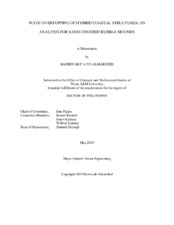| dc.description.abstract | Considering the accelerating sea level rise, population growth, and coastal developments, the risks associated with extreme storms are expected to increase. To meet this dilemma, hybrid coastal approaches are being employed in various coastal communities. Hybrid coastal approaches can offer protection against flood and coastal erosion while adding recreational value to the coastal areas. Despite all the inherent benefits, many knowledge gaps relevant to their performance still exist. In addition, there is no design framework for these structures. This dissertation focuses on advancing the knowledge of physical processes related to wave-sediment-structure interactions. The first empirical formula to predict wave overtopping rate of a hybrid coastal structure consisting of rubble mound covered by a varying finite sand layer was developed. A physical model experiment consisting of 32 trials, including both the pure rubble mound and the hybrid structures, was conducted in a wave flume with moveable-bed capabilities. A Froude scaling factor of 1:20 was selected to fit the prototype structure properly in the wave flume. Irregular wave trains with significant wave height, Hvmo, of 9 – 12 cm and peak wave periods, Tvp, of 1.64 – 1.9 s were tested. The morphological evolutions of the modeled hybrid structure were captured by laser line scanner measurements. The hydrodynamic conditions were measured by capacitance wave gauges. Acoustic Doppler velocimeters were used to estimate the kinetic energy. An empirical formula to predict the average wave overtopping rate was proposed using nonlinear regression. The analysis and the formula show a high dependency of the average wave overtopping rate on the dimensionless parameter Rvchvt/H/2/o. The data correlate well with the proposed equation (R-2 = 0.72). The instantaneous wave overtopping rate was found to be best represented by the Weibull distribution where the correlation between the data and the distribution was 0.998. The findings of this study can aid in understanding the processes related to wave overtopping of a hybrid coastal structure. In addition, this study can help decision makers to select the best protection scheme for their coastal communities, based on the capability of the presented structure in reducing flooding and wave energy. | en |


